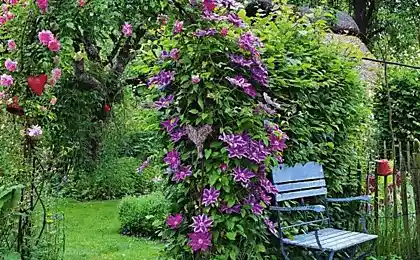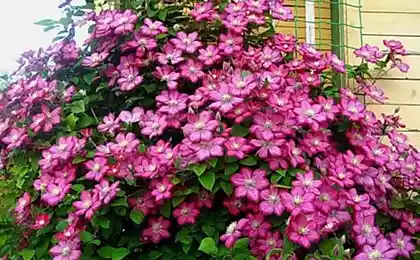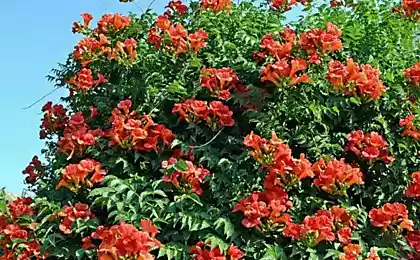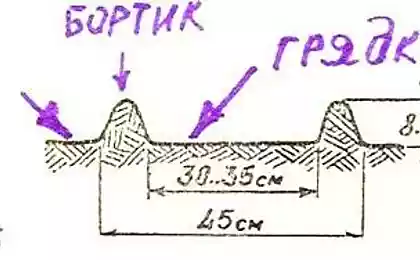536
Growing clematis: myths and reality
The clematis I was fascinated many years ago. Still working at the station of young naturalists acquired his "firstborn" — a sort of "Fantasy".
Gathered over many years a solid collection of clematis with over 50 varieties. I never cease to marvel at these vines, at the Royal majestic in time of its blossom!
Clematis is one of the most spectacular and grateful of vines of exceptional beauty. Hardly a perennial plant that can delight the eye with their variety in color, numerous and large flowers for such a long period – more than three months!
In relation to the difficulties involved in keeping clematis among gardeners there is a lot of conflicting opinions.
As a rule, novice growers are scared, considering the cultivation of clematis something almost heroic and are available only to the elite…
Fifty five million eight hundred twenty nine thousand nine hundred thirty one
Based on our many years of experience with the clematis, I would like to dispel some of the myths associated with this creeper.
The first myth:growing clematis is very problematic
Everything is relative. If you are struggling to cope with several rose bushes (which now adorn many gardens!), the care of the clematis much easier.
I believe that the contents of the clematis is a simple matter, requiring much less effort than the maintenance of roses. But in this case, you need to be patient.
Many novice growers are disappointed that even after two years of cultivation can not get from their clematis the same exuberant flowering, what is striking in the photo in specialized magazines and advertising catalogues. Starts self-flagellation, there is a lack of confidence in their own abilities, give up…
But weak flowering clematis at first, there is a simple explanation! Biological feature of clematis is that at least the first three years, all of the effort spent on building up the root system and the formation of multiple buds resume at the base of the Bush. Therefore, the ground part of the vine at this period of development is characterized by intensive growth. Accordingly, riotous bloom from a clematis should be expected.
But this does not mean that you do not see flowers during the build roots.
With good care you have planted cuttings of clematis already for next season, by August-September, the buds appear and open the first flowers.
Experts advise not to give to bloom the seedlings of clematis in this period with the aim of strengthening the plants. However, I always wait for the dissolution of the first flower on the new clematis.:) The curiosity is jammed — whether the plant purchased on that count?
From their own bitter experience I know that re-grading of clematis, alas, present — and when you buy seedlings at the market, and when you order from major flower firms.
Seeing the first blooms of the new clematis and having satisfied their curiosity, I limit its growth. Seedling are pruned to 50-60 cm, giving young clematis opportunity to gain strength until frost for successful hibernation.
Twenty seven million four hundred sixty six thousand seven hundred sixty one
Impatient novice growers will say that in the first years of life clematis may not bloom at all. I had to wait for 3-4 years until purchased seedlings flowering for the first time. What is the reason — for me it still remains a mystery. Involuntarily start to think about the negative energy the seller; the self-blame in the least…
The most hurtful in such cases, that after waiting early flowering clematis for so long, the result of find absolutely not the variety that was purchased.
So I was disappointed bought at the Moscow flower show plants of clematis: after years of waiting were again re-grading.
I had with clematis is another interesting situation. Since I have been breeding clematis, trying to quickly reproduce the attractive varieties.
Once I bought in July, a new variety of clematis. Immediately several shortened sapling and put the trimmed shoots for cuttings.
Imagine my surprise when the following year my cuttings-"weakling" bloom before the mother plants, which by this time was a three-year period. Miracles, and more!
The second myth:problems with the winter clematis
The second myth States that clematis are hard to prepare for winter, they can not tolerate.
Let's start with the fact that the plant belongs to the family Ranunculaceae is one of the most resistant and cold-resistant. Clematis start to grow, when in the garden somewhere else and the gleaming snow. The unfolding leaves of clematis without any harm to the plants withstand significant spring frosts (up to -5...-8 degrees).
The most dangerous thing in the winter clematis – the stagnation of the spring melt water at the base of the Bush. In order to prevent this, in the autumn it is necessary to pour for each plant about a bucket of peat or humus, forming a small mound.
In the spring, when the ground is thawed, it is necessary to carefully shovel the extra soil, freeing the base of the Bush.
Small artificial clematis require shelter only in the first 2-3 years after planting while young plants will not get stronger. Then they can build in a season of powerful green weight.
In the future, before winter it will be enough after the autumn pruning clematis the rest of the ground part to ruthlessly rip off the supports and lay on top. Numerous twisted shoots of clematis form a loose, disminuyen shelter with excellent ventilation, well check the snow at the roots.
When preparing clematis for the winter should take care to protect them from mice.
This is especially true when using artificial shelters (plastic film, roofing material) shoots of clematis for the winter. Climbing into a cozy dry tunnel, rogue rodents are satisfied there their nests, blowing their arrangement of stubby twigs of clematis.
After one such wintering my eyes appeared in the spring destroyed by mice (at the root) all shoots of clematis planted in rows and covered the top with foil.
But then they quickly grow new shoots, but in that year I lost the opportunity to admire early flowering clematis victims.
Since then, every autumn, I necessarily laid out under every Bush clematis poisoned bait against mice.
Seventy eight million two hundred ninety five thousand three hundred thirty one
The third myth: the advantage of clematis, flowering on young shoots
The third common misunderstanding concerns the fact that it is better to buy varieties of clematis, flowering on young shoots. It affects the analogy with climbing roses.
Indeed, there is a group of roses that bloom only on last year's shoots. In case of death of shoots in winter, next season the growers are forced to admire only re-grow the affected climbing roses branches, and regret the absence of flowering…
With the clematis, the situation is quite different. Not even maintaining last year's shoots of clematis, you will still enjoy its summer bloom on young branches.
This group of clematis, flowering on shoots of last year, in my opinion, even preferable, because their flowering season is long. They have the first buds begin to bloom, sometimes even in late may (it's something we have in Vitebsk!).
And it is to this group is the most plush varieties of clematis.
Surprises Terry varieties of clematis
About double clematis I would like to talk separately. They are at the peak of popularity; the cost of seedlings is significantly higher than varieties with flowers undouble.
clematis "SuperMulti»
Looking at the double flowers clematis incredible shape and stunning beauty, at times verging on the gorgeous peonies — I can't believe it is a flower of clematis!
However, for some reason, almost none of the sellers do not make available to buyers information about the fact that almost all the double varieties of clematis are battling for its unusual flowers only in the first wave of flowering to hibernating shoots (June-beginning of July). And then on the vines bloom simple nemahrovymi flowers…
Of course, this fact for true fans of the clematis, not so important, because in no way does not reduce further the decorative vines. Very often undouble summer flowering clematis Terry is much more abundant and brighter (for example, grades of "Veronica Chois", "Miss Cholmondeley", "Louise Rav").
But still, novice gardeners need to know about this particular Terry clematis, to be ready for them undouble flowering.
So if you purchased a seedling of clematis double varieties, and it then bloomed single nemahrovye flowers, — should not hurry with accusations against the dishonest seller!
If flower color of the seedling double varieties coincided with the statement, then have patience until next season and try to keep winter from the shoots of clematis.
The choice of method of crop seedling of clematis
Many growers experience difficulty when selecting a method of pruning clematis. This difficulty is also connected with the lack of information.
All varieties of clematis can be divided into 2 groups:
1 — only flowering on young shoots of the current year;
2 — blooming, and the old last year's shoots, and young.
Therefore, acquiring a seedling of clematis, it is necessary to clarify from the seller: to what kind of group is this variety?
However, this can be difficult — because often the sellers have no idea what they sell…
If you do not receive this information on time or faced with the regrading of clematis, do not despair. Please be patient and watch a couple of years for a new plant.
Leave the winter on old stems of clematis (about 50 cm in length). And spring note: what is the maximum height there will be an awakening of the kidneys. Let's see where it will begin the dissolution of the first flowers.
If within two years old shoots of clematis after wintering lifeless, and the young shoots only appears from the earth (or of the lower buds old shoots), it means that the plant belongs to the first group.
Then feel free to cut in autumn, almost the entire terrestrial part of the clematis, keeping the shoots length of only 25-30 cm from the ground.
I leave the first group of clematis shoots of this length with the only goal to spring to fix them on the trellis and give initial support to the emerging young shoots.
In care instructions for some kinds of clematis is recommended to keep the old stems in winter to ensure early flowering. This means the ownership of the varieties of the second group.
But this does not mean that you need to carefully take care of the whole green mass of clematis from summer growth. Some varieties of clematis it reaches more than three meters. While the apical part of the shoots is still not matured to the end of the season and fails to produce viable buds.
So it is enough to save for the winter only the lower part of the shoots of the clematis, about 60-100 cm (the length depends on the climatic zone and the variety of features; is selected empirically). And the rest of the green mass you can put on the winter shelter of clematis.
On the strength of the woody shoots of clematis
Do not be afraid of fragility of the woody shoots of the clematis!
It happens: autumn received in the mail a seedling of clematis, many novice gardeners are in vain panic, noticing nadlomilsya stem.
First, the basic buds of clematis are at the base of the Bush, near the root collar (where the regrowth of the roots).
Second, woody escape clematis fragile is only the outer layer – the cortex. And the escape is very durable! Rather, it is possible to injure their hands than we can break.
Therefore, taking the fall with the supports stacking and lignified shoots of clematis for winter, you should not flinch at the slightest roaring bark...
Sixty five million one hundred fifty one thousand seven hundred sixty
The vulnerability of young shoots of clematis
But young shoots of clematis, growing in the spring, do require very delicate and careful treatment. Though they are powerful, but juicy and very fragile.
It is therefore necessary to provide decent support for vulnerable young shoots of clematis for the first time until they get stronger.
Do not forget about the fragility of the delicate shoots of clematis, when the impatient novice grower causes him to dig the soil around the Bush. Because sometimes I want to make sure that the seedling of clematis adequately coped with the winter…
Say this based on my own experience. I, too, initially repeatedly injured the top make your way to the world of underground shoots of clematis while trying to reassure itself that the seedling died.
In this case, the plant slows its growth, launching a backup of the kidneys.
Don't rush to pull out "dead" clematis
The main thing – to have patience and not to panic, if the spring on the landing spot of clematis you suddenly find only a dried twig…
This primarily concerns young autumn planting clematis, but true for adult plants.
If for some reason the place adult of clematis, has already pleased you with its extraordinary flowering in the spring or even the middle of summer does not appear any of Rostock is not in a hurry to take a shovel and uproot the Bush!
One day after a very severe winter for a long time showed no signs of life, my "firstborn" — clematis variety "Fantasy".
I think in this case, the negatively triggered by a number of factors: advanced age of the vines (over 10 years), and Spartan growing conditions (the relentless sun, landing in a construction piles).
Imagine my surprise when after FOUR years of land suddenly has a new sprout "Fancy"!
Don't be afraid to plant clematis in your garden. grow these chic creepers. They are incredibly decorate your garden and change its appearance so that you will forever be fans of these spectacular plants. published
P. S. And remember, only by changing their consumption — together we change the world! © Join us at Facebook , Vkontakte, Odnoklassniki
Source: vk.com/dacha.life?w=wall-83256656_12064
In the Netherlands are testing the servers to heat homes
One glass of this drink before sleep and You will get rid of excess weight!






















